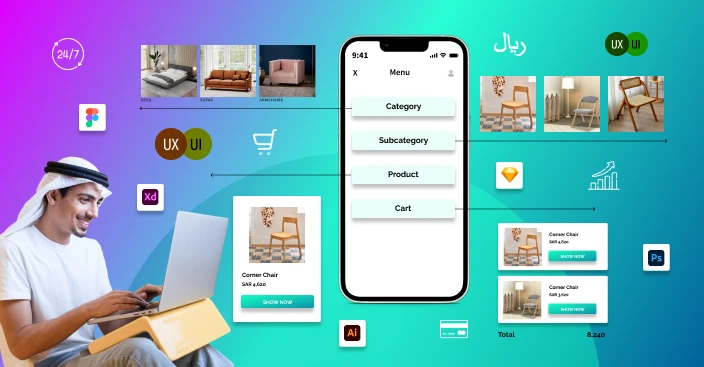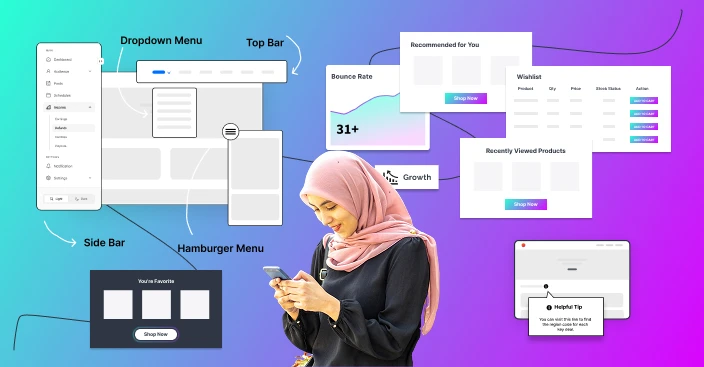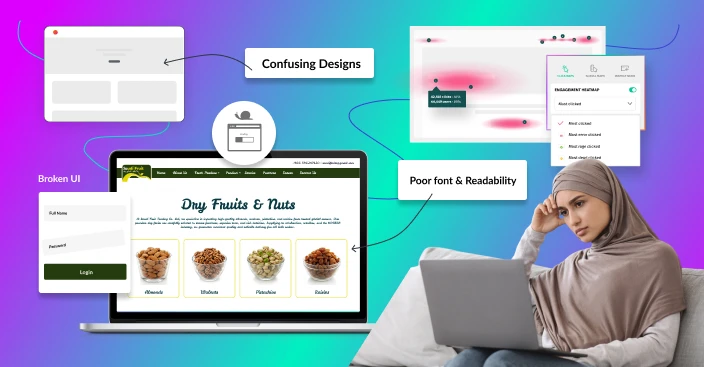What Makes UX/UI Design Crucial for Saudi Arabia’s Growing eCommerce Market?

Table of Contents
With Saudi Arabia’s b2c eCommerce environment picking up speed at a breakneck pace under Vision 2030, businesses are fighting tooth and nail to discover an online competitive edge.
Perhaps the most underestimated yet most basic force driving this online competition is User Experience (UX) and User Interface (UI) design.
Whether you’re launching a new online storefront or revamping an existing one, your design choices have a direct impact on your bottom line.
As the Saudi market is growing with the increasing need for experience-driven stores, with simple and easy to use UX/UI. Hence it’s not an option, it’s a prime requirement.
This blog explores why UX/UI design is central to ecommerce development and success in Saudi Arabia. It highlights how thoughtful design powers your conversions, customer loyalty, and trust in your brand. You’ll also discover practical steps to enhance your online storefront as part of a well-rounded ecommerce development strategy.
What is UX/UI Design
UX is the way in which your users interact with your site or app, considering experience, navigation, and overall satisfaction.
UI concerns visual organisation, controls, and interaction design. Both play a part in the beginning-to-end digital experience that decides how customers get to know and interact with your brand.
Saudi Arabia’s eCommerce economy is expected to surpass $25 billion in 2026 and is set to expand to more than $49 billion in 2030, growing at a rate of close to 12% annually. This. This eCommerce bubble madness is due to a 99% internet-penetrated populace at 214 Mbps average mobile download speed.
73% digital payment card boom in March 2025, It’s nearly impossible to imagine that brands don’t make world-class digital experiences since, without a solid UX/UI core, companies are missing out on an increasingly mundane, more technology-focused and competitive market.
To Saudi businesses competing in this rapidly digitising space, UX/UI design will be determining user stay time, purchase completion, and repeat visits.
Inefficiently designed layout, unintuitive navigation, or visually overwhelming interface can immediately turn users off, but good intuitive design can lead them well from discovery to checkout.
Why UI/UX Designs are the Building Block of Digital Experience
Mobile-First and Culturally Unique
Saudi Arabia boasts one of the world’s highest smartphone penetrations, with more than 97% of its population using mobile phones.
Its pervasiveness within the mobile is something that compels eCommerce websites to grant high priority to mobile-friendly, responsive, mobile-first design.
Already, mobile commerce has represented almost 64% of total eCommerce transactions in 2023, and with the growth in the user penetration to 74.7% in the year 2027, the number will continue to increase.
Other than that, the Saudi market also features cultural sensitivities influencing design preference. The overriding language is Arabic, and that requires RTL (right-to-left) support in websites and apps.
A site written predominantly in English or non-RTL-supportive will keep Arabic-speaking visitors away. Even graphics and images, as well as colour palettes, must be locale-friendly with aesthetics and tradition to the extent of offering the experience of cultural identification and respect to users.
First Impressions are Everything
Users judge a website within only 0.05 seconds. Speed, design, and layout affect this first impression. As competition intensifies in Saudi Arabia’s online arena, your first impression makes or breaks your brand.
A well-crafted, contemporary UI instils trust, whereas slow page loading and disorganised layouts infuriate shoppers.
Since more than 77% of Saudi Arabian internet consumers abandon carts, making sure your look and feel are as sleek as they can be is essential to stay engaged and make sales.

Direct Effect of Design on Revenue
UX/UI decisions have a direct impact on your CRO. The Saudi Arabian average eCommerce conversion rate is 2.1% add-to-cart rate of 9.3%.
Small UX frictions, such as poorly structured navigation or confusing checkout, can translate into enormous losses in revenue.
Local payment options such as MADA or STC Pay, streamlined checkout flows, and mobile-optimal optimisation are all potential to boost your results by leaps and bounds.
Noon and Amazon.sa are excellent examples through Arabic UX, responsive design, and optimised buying flows.
Integrated into the Experience
As Saudi customers increasingly shop digitally, trust has to be earned and upheld. Secure payment processes and a solid backend infrastructure are important, but UX/UI design is also key to reinforcing trust visually and operationally.
Aspects such as prominent payment method badges, clear return policies, SSL security certificates in view, and authentic customer reviews all play a part in making the buying process safe and open.
When shown in a tidy, uncluttered structure, such design indicators create feelings of safety and professionalism, is leading users to make those purchases with confidence.
Repeat Visits and Brand Loyalty
A seamless initial buy is wonderful, but real brand triumph comes in having customers return. Seamless re-engagement is essential in fueling repeat buys and sustained loyalty.
Trusted features such as saved shopping carts, order tracking in real-time, one-click re-order, and customised loyalty dashboards benefit consumers and make their experience easier.
For example, Carrefour KSA provides an outstanding interface where consumers can simply re-order previous orders and keep track of loyalty points balances, transforming occasional consumers into long-term loyalty by virtue of innovative design and hassle-free usability.
Multilingual and Bilingual Customer Design
With the help of multilingual features the brand can connect with a diverse customer base in Saudi Arabia. As most of the users are using Arabic, and having this language access is not only a good thing to have but important.
This feature is also associated with the need for flexibility to change, so the users can change seamlessly between Arabic and English without any layout interruption, design changes, or content misalignment.
By integrating a language switcher your users must access the desired language for every page, it will enable users to switch languages with ease.
Top platforms such as Amazon.sa provide a consistent and intuitive bilingual experience, maintaining the same structure, flow, and visual appearance irrespective of preferred language, for improving usability and inclusivity for all consumers.
Implementing UX/UI in Omnichannel Strategies
Saudi consumers today engage with brands across various digital touchpoints, for websites, mobile app development, Instagram stores, WhatsApp, and even retail kiosks.
In order to remain relevant, UX/UI needs to bring together these touchpoints with a single, brand-consistent experience.
Regardless of whether a user is browsing on an app, checking out through Instagram, or monitoring an order via WhatsApp, the design language, operations, and brand markers should be identical.
Shein and Zara are prime examples, designing visually beautiful and functionally coordinated experiences on all channels.
This type of cross-platform UX concordance fosters brand credibility, enhances trust, and invites persistent interaction.
Avoid Common UX/UI Pitfalls
Cluttered Design
The excessive amount of elements crowding your interface overwhelms users and dilutes your brand message.
Go for white space, clear visual hierarchy, and concise copy. This helps direct the users’ attentions, not away from important interactions, especially in the hectic eCommerce spaces like the growing digital market in Saudi Arabia.
Confusing Navigation
Users depart in a hurry when they are unable to access what they require. Clear, consistent navigation with intuitive menus and breadcrumb trails makes for easy journeys.
Use familiar icons and organise logically. For Saudi users, local reading habits and preferences should inform structure for improved accessibility and cultural convenience.

Unoptimised Mobile Usability
In Saudi Arabia, mobile-first is not negotiable. Awful mobile UX including small buttons, long loads, or unviewable content, it is costly in terms of conversions.
Use responsive design, quick loading, and touch-friendly interfaces. Optimise mobile features for thumbs and enable Arabic support to match expectations and improve the user experience on smartphones.
Translation Errors
Poor translations damage credibility. Employ human localisation, not automated software. Arabic content must be culturally correct, contextually appropriate, and visually structured as right-to-left.
Proper phrasing and local idioms enable Saudi users to feel appreciated and enhance brand trust throughout multilingual eCommerce sites.
Lack of Regular UX Audits & Testing
UX isn’t one-and-done. Conduct regular audits, gather feedback, and run A/B tests to optimise continuously.
Include Saudi-specific user behavior data to refine designs. Iterative improvements based on real usage lead to better usability, more engagement, and higher conversion rates over time.
Conclusion
Design with UX/UI experts who know Saudi digital culture to produce successful, scalable UX. With local expertise, your design will feel and perform like a native application, from right-to-left designs and local payment networks to Arabic typography and color psychology.
Saudi Arabia’s eCommerce future is mobile, digital, and rapidly growing. To grow and to survive, your UX/UI design needs to keep up.
From establishing trust to optimising conversion rates, your design is no longer just a question of how pretty it is. It’s a business growth tactic.
Ready to launch your eCommerce store in Saudi Arabia to new heights? Let our UX/UI expert team help you to create experiences that convert.
FAQ
Q1. Why should UX/UI design matter to my Saudi Arabia online business?
Since it directly impacts user behaviour, trust, and buying on your site, particularly in an accelerating, mobile-first economy.
Q2. How can a bad UX/UI design damage my e-commerce sales?
If the audience is not satisfied with your store design, It will results in high bounce rates, cart abandonment, and missed conversions through frustrating or confusing user experiences.
Q3. What are some aUX/UI risks to avoid on online sites?
There are a few risks that need to be avoided, such as slow loading sites, messy layouts, non-mobile, poorly translated Arabic, and complex checkouts.
Q4. Does UX/UI design establish customer trust in Saudi Arabia?
Yes, particularly with increasing online fraud on the horizon. Clean designs, safe payment images, and Arabic support establish trust.
Q5. How to ensure a seamless UI/UX for my e-store in Saudi ?
Mobile-first design, Arabic localisation, fast checkout, and concise navigation, and a option for integrating with local payment methods.
Q6. Why is UX/UI design can be a transformative approach for Saudi brands?
It allows companies to differentiate, convert, and build long-term loyalty in a competitive Saudi marketplace. With a clean and easy-to-use retail store the end-users can get the actual benefits.
Q7. How does UX/UI design impact repeat visitors and loyalty?
With the help of a seamless, personalised experience, and structured UI/UX design the users can get the best experience. Which will increase the chances of repeat business and word-of-mouth from your store.



